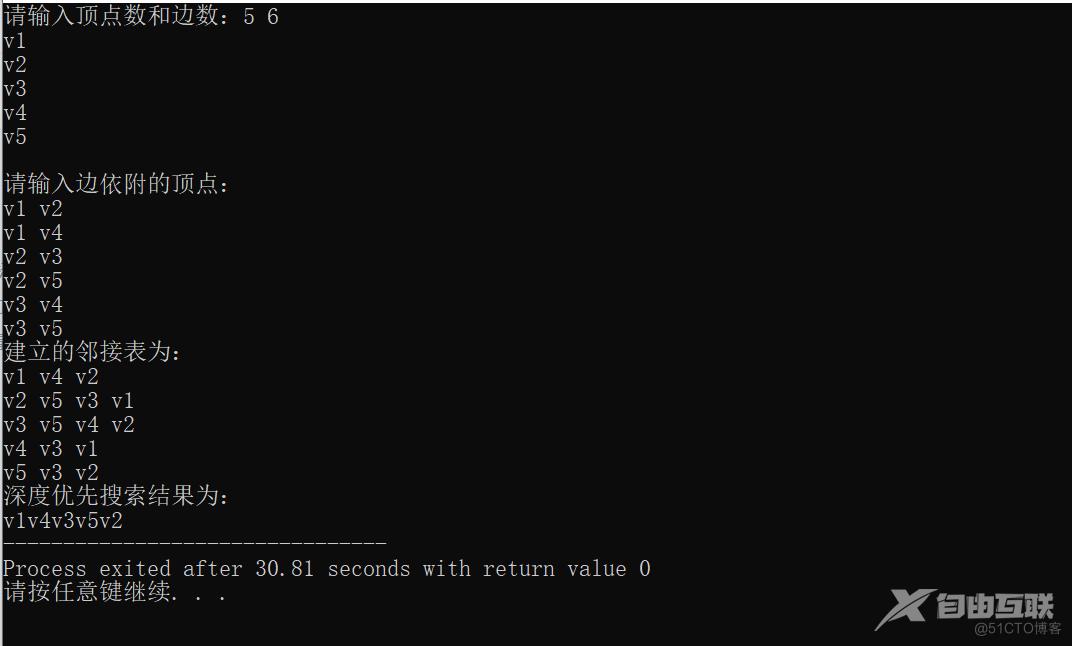#define MAX_VERTEX_NUM 20#includestdio.h#includestring.h#includestdlib.h#define TRUE 1#define FALSE 0#define OK 1#define ERROR 0#define INFEASIBLE -1#define OVERFLOW -2#define NULL 0typedef int Status;typedef char VertexType[20];typedef cha
#define MAX_VERTEX_NUM 20
#include<stdio.h>
#include<string.h>
#include<stdlib.h>
#define TRUE 1
#define FALSE 0
#define OK 1
#define ERROR 0
#define INFEASIBLE -1
#define OVERFLOW -2
#define NULL 0
typedef int Status;
typedef char VertexType[20];
typedef char InfoType;
typedef struct ArcNode
{
int adjvex;
struct ArcNode *nextarc;
InfoType *info;
}ArcNode;
typedef struct VNode
{
VertexType data;
ArcNode *firstarc;
}VNode,AdjList[MAX_VERTEX_NUM];
typedef struct
{
AdjList vertices;
int vexnum,arcnum;
int kind;
}ALGraph;
int visited[MAX_VERTEX_NUM];
Status (*VisitFunc)(ALGraph G,int v);
Status LocateVex(ALGraph G,char *v)
{
int i;
for(i=0;i<G.vexnum;i++)
if(!strcmp(G.vertices[i].data,v))
return i;
return -1;
}
Status Create(ALGraph *G)
{
int i,j,k;
char v1[20],v2[20];
ArcNode *p,*q;
printf("请输入顶点数和边数:");
scanf("%d%d",&G->vexnum,&G->arcnum);
for(i=0;i<G->vexnum;i++)
{
scanf("%s",G->vertices[i].data);
G->vertices[i].firstarc=NULL;
}
printf("\n请输入边依附的顶点:\n");
for(k=0;k<G->arcnum;k++)
{
scanf("%s%s",v1,v2);
i=LocateVex(*G,v1);
j=LocateVex(*G,v2);
p=(ArcNode*)malloc(sizeof(ArcNode));
p->nextarc=G->vertices[i].firstarc;
G->vertices[i].firstarc=p;
p->adjvex=j;
q=(ArcNode*)malloc(sizeof(ArcNode));
q->nextarc=G->vertices[j].firstarc;
G->vertices[j].firstarc=q;
q->adjvex=i;
}
}
int FirstAdjVex(ALGraph G,int v)
{
ArcNode *p;
if(p=G.vertices[v].firstarc)
return p->adjvex;
return -1;
}
int NextAdjVex(ALGraph G,int v,int w)
{
ArcNode *p;
for(p=G.vertices[v].firstarc;p->adjvex!=w;p=p->nextarc);
if(p=p->nextarc)
return p->adjvex;
else
return -1;
}
void DFS(ALGraph G,int v)
{
int w;
visited[v]=TRUE;
(*VisitFunc)(G,v);
for(w=FirstAdjVex(G,v);w>=0;w=NextAdjVex(G,v,w))
if(!visited[w])
DFS(G,w);
}
void DFSTraverse(ALGraph G,Status (*visit)(ALGraph G,int v))
{
int i;
VisitFunc=visit;
for(i=0;i<G.vexnum;i++)
visited[i]=FALSE;
for(i=0;i<G.vexnum;i++)
if(!visited[i])
DFS(G,i);
}
Status func(ALGraph G,int v)
{
printf("%s",G.vertices[v].data);
}
int main()
{
ALGraph G;
ArcNode *p;
int i;
Create(&G);
printf("建立的邻接表为:\n");
for(i=0;i<G.vexnum;i++)
{
printf("%s ",G.vertices[i].data);
for(p=G.vertices[i].firstarc;p;p=p->nextarc)
printf("%s ",G.vertices[p->adjvex].data);
printf("\n");
}
printf("深度优先搜索结果为:\n");
DFSTraverse(G,func);
return 0;
}
